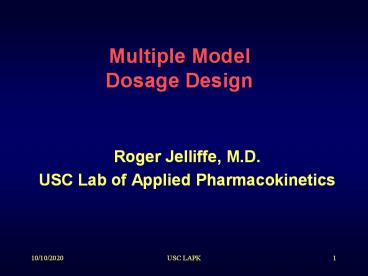Multiple Model Dosage Design - PowerPoint PPT Presentation
Title:
Multiple Model Dosage Design
Description:
Consider the effects of the pop outliers. Do a clinical simulation to validate each ... as made by Mallet. 11/26/09. USC LAPK. 7 'Multiple Model' Dosage Design ... – PowerPoint PPT presentation
Number of Views:276
Avg rating:3.0/5.0
Title: Multiple Model Dosage Design
1
Multiple ModelDosage Design
- Roger Jelliffe, M.D.
- USC Lab of Applied Pharmacokinetics
2
Conventional Design of Drug Dosage Regimens
- Use Population Model
- Select single target goal
- Develop the dosage regimen to hit target
- But will it? How precisely?
- How to evaluate the expected precision?
3
(No Transcript)
4
Optimal Drug Dosage
- Consider the effects of the pop outliers.
- Do a clinical simulation to validate each
regimen. - Standard Doses no feedback. Optimize them to
hit desired targets. - Cancer Rx, Veterinary Rx.
- Individualized Doses Optimize them also.
- Targets are desired Conc, AUC, etc
- AIDS, Transplants, Cancer, Antibiotics,
Cardiovascular, etc.
5
What is the BEST Pop Model?
- The correct structural PK/PD Model.
- The collection of each subjects exactly known
parameter values for that model.
6
An NPML Population Joint Density, as made by
Mallet
7
Multiple Model Dosage Design
- Start with multiple models in pop model
- Best starting tool NPAG joint density.
- Compute regimen having least weighted squared
error in target goal achievement.
8
(No Transcript)
9
Continuous IV Vanco. Predictions when regimen
based on means is given to all subjects
10
Vanco, continuous IV. Predictions from MM regimen
11
MM Optimal Dosage Regimens
- Consider the quantitative effect of outliers.
- A built-in simulated clinical trial each time.
- Achieve target goals with max precision.
- Get the best overall standard dose.
- Best for Vet use, without feedback.
- Best for Patient use, with or without feedback
- cancer, AIDS, inf. Disease, CV disease. - Best optimally coordinated combination regimens
in future.
12
Clinical Illustrations
- Planning the initial regimen
- Adjusting it based on TDM data































